10 Popular Types of Pasta to Try in Italy on Vacation
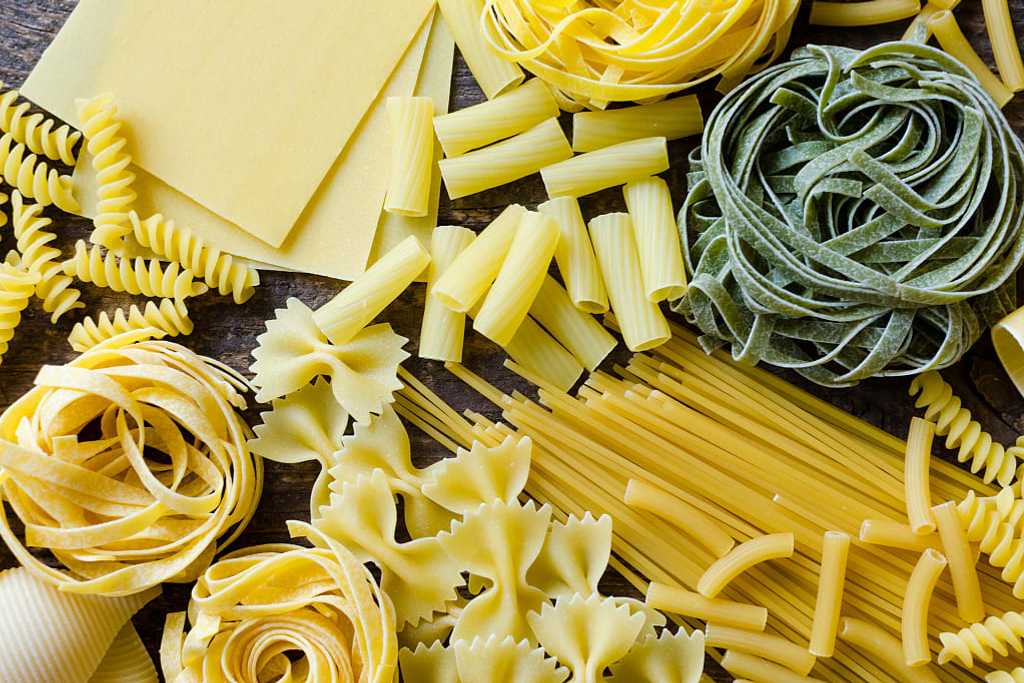
Italian pastas
Italy is home to thousands of different pastas to try during your personalized trip, each with its own distinct shapes and flavors that stem from the unique regions found across the peninsula. Italian noodles represent over 300 pasta shapes, each playing an integral role in the local cuisine and revealing the culinary personality of different regions and their gastronomic heritage.
The country’s variety of pasta has a history dating back to Marco Polo in the 13th century and myths that trace their origins to nomadic Arabs who brought noodles to Europe from Central Asia. No matter the genesis of Italy’s different pastas, they have inspired shapes and sizes from the different ingredients available in the country’s differing regions.
Emilia-Romagna is considered the food capital of Italy, but we have compiled a list of the 10 most-popular pastas in Italy and in what regions you can find them as you tour the country and savor delicious local dishes.
1. Spaghetti • Sicily
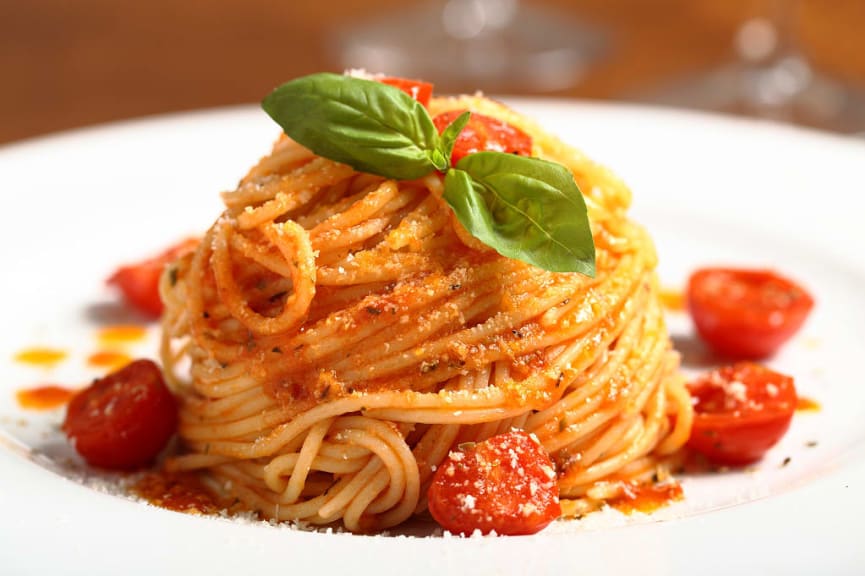
Spaghetti al pomodoro
Spaghetti is Italy’s classic pasta and commonly found in Sicilian dishes you can try during a Sicily tour and vacation. Typical spaghetti is made from water, milled wheat, and flour, but authentic spaghetti is made with durum wheat semolina.
Commonly, spaghetti in Italy is served with tomato and meat sauces, or vegetables during the primo courses of lunch or dinner.
Spaghetti recipes differ based on region, with the south using dry noodles and the north preferring fresh ones. Italian spaghetti varies tremendously from the world’s store-bought variations, so do not skip spaghetti when you travel to Italy.
2. Ravioli • Lombardy

Ravioli stuffed with spinach
Ravioli is a popular square-shaped pasta stuffed with different ingredients like meat, cheese, or vegetables. It originated in the northern region of Lombardy, but spread across Italy, resulting in numerous variations based on local, seasonal, and accessible ingredients.
The stuffed pasta, made from a mixture of egg, flour, and water, is served with a broth or topped with sauces that accentuate the fillings.
Circular variations of ravioli are known as mezzelune, or “half-moons”, so be on the lookout for both when visiting the country. Explore new ways to sample classic dishes during your Italy trip with our Northern Italy travel guide.
3. Penne • Campania
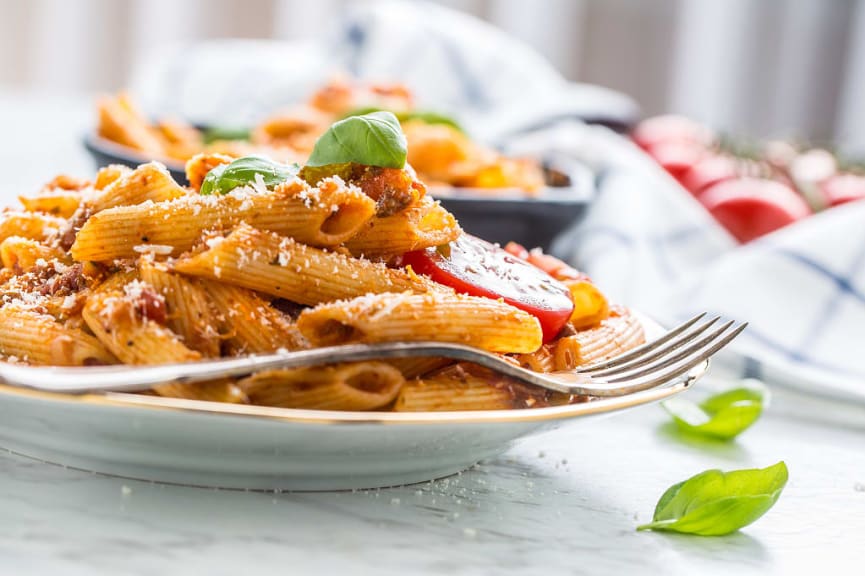
Pene with bolognese sauce
Penne has become one of the 10 most-popular pasta noodles in the world by volume. The small, cylindrically-shaped pasta generally resembles the tip of an old-fashioned quill or pen, which inspired the noodle’s singular name, “penna”.
In Sicily, penne is stuffed with spinach and ricotta cheese, or topped with tomato or cream sauces. In Liguria, durum wheat and ingredients, namely spinach, wheat, and tomatoes, create the tri-color noodles that resemble the Italian flag.
Larger types of penne noodles are known as mostaccioli and some differ in texture, with smooth or ridged exteriors. Sharing meals is a common pathway to unforgettable experiences. You can explore more of Italy’s gorgeous landscape around the Campania region and how it intertwines with the ingredients that shape local cuisine with our 10 most romantic places in Italy for couples.
4. Macaroni or Elbows • Campania

Macaroni
Elbow-shaped maccheroni is one of Italy and the world’s most-famous noodle shapes.
While the North American dish macaroni and cheese and Victorian English sweet macaroni pudding use a mass-produced version of maccheroni, they pale in comparison to the original that you will only find during personalized Amalfi Coast tours and vacations or when traveling to certain corners of northern Italy.
The small, slightly curved tubular design makes macaroni versatile for baking dishes, soups, or anything with heartier vegetable sauces. Macaroni, made from durum wheat, originated in northern and central Italy, and is derived from the ancient Greek dish of barley served in broth.
5. Lasagna • Emilia-Romagna

Lasagna
Lasagna is a long, flat noodle that resembles a sheet of pasta. Lasagna has dueling origin stories, one stating its origins in Naples from noodles made with heavier edges to better layer the pasta over ingredients, another connecting the dish to Bologna.
Typically, various sauces and cheeses are layered with the pasta before being baked in a type of casserole. The famous cartoon Garfield popularized the Italian pasta type and has since become a staple worldwide.
The first documentation of lasagna dates back to Ancient Greece and Italy’s Middle Ages. There is nothing quite like the experience of your first bite of lasagna, especially when visiting during one of Zicasso’s exclusive itineraries to Emilia-Romagna.
6. Gnocchi • Veneto

Potato gnocchi with creamy basil sauce
The famous Italian pasta known as gnocchi is a dough dumpling cut into small pieces that resemble a cork and celebrated in dishes around Veneto, a region that includes the elegance and charm of famous canals during a Venice vacation and tour.
Gnocchi can be made with potatoes, spinach, eggs, ricotta, and other types of cheese. Its origins date back to the Roman Empire, but it has become a pasta primarily associated with modern Italy. The dumplings are often made from semolina wheat flour and flavored with herbs, vegetables, or similar ingredients.
As you travel in Italy, you will come across menus that mention various regional names for gnocchi, such as gnudi, malfatti, malloreddus, strangulaprievete, or cavatelli.
7. Linguine • Liguria

Linguine with mussels
Linguine is known for its long, thin, elliptical shape. It is popular in the region of Liguria, most notably in the capital city of Genova, and is made from durum wheat semolina flour.
The noodles' texture and length help carry the typical toppings of pesto sauce or seafood. Linguine is often seasoned with pesto, green beans, and potatoes, and today it is typically served during the primo courses of lunch or dinner in Italy, before a fish or meat dish.
As you travel through Italy, you can expect to find linguine recipes that include anchovies and pine nuts, or are used with clam sauce and various red sauces like arrabbiata. Tour Cinque Terre to further enjoy the flavors of Liguria and the possibilities of cooking with linguine.
8. Vermicelli • Campania

Raw Italian vermicelli
The Vermicelli noodle has a long, rounded, thin shape similar to spaghetti, but with a thicker body. In the United States, vermicelli noodles have a thinner body than regular spaghetti, which separates them from the traditional Italian variation.
Italian vermicelli dates back at least to the 14th century and the typical vermicelli recipe showcases southern Italian cuisine with dishes like Neapolitan Vermicelli, which contains lard, tomatoes, pepper, and Pecorino cheese, or the typical dish of Vermicelli alla Puttanesca.
When on a custom-tailored Southern Italy tour, you can find dishes that highlight the flavorful combinations of vermicelli served during lunch or dinner as the primo course of the meal.
9. Cannelloni • Sicily

Cannelloni pasta stuffed with ricotta
Cannelloni, also referred to as manicotti, is an Italian pasta with a tube or cylindrical shape that measures approximately three to four inches in length. The noodles are made from durum wheat flour and water, and are often stuffed with cheese, meat, vegetables, or fish.
It is usually served during the primo course of a traditional Italian lunch or dinner, before a meat or fish dish.
The word “cannelloni” literally translates to “big pipe”, and you can expect to find these noodles commonly served with a rich ragù topping, tomato sauce, or a hearty béchamel during your Italy travels that often embody the robust flavors unique to island cuisine, especially when on a two-week Sicily itinerary.
10. Fettuccine • Valle d’Aosta
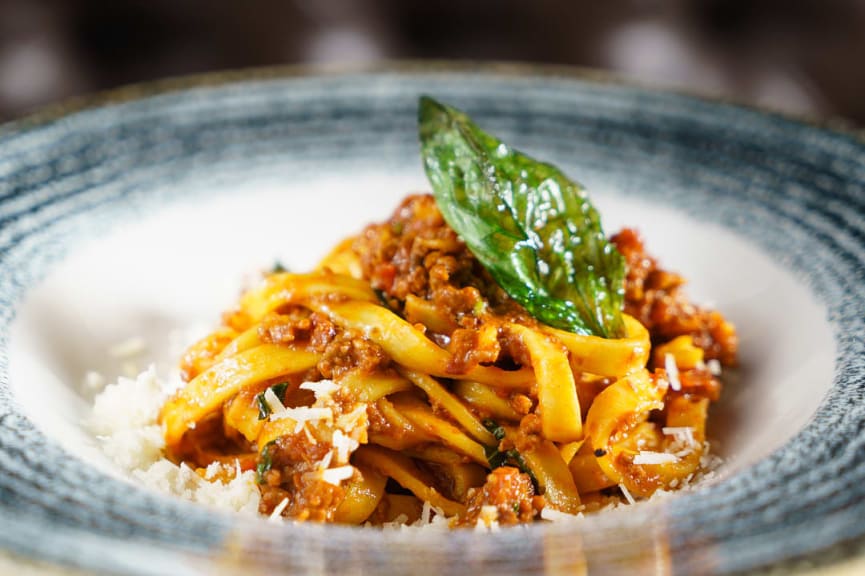
Fettuccine with ragù
The famous Italian pasta fettuccine has a long, flat-ribbon shape with a thickness that measures up to 10 inches long. The pasta is made from egg and durum wheat flour typical of the central and northern regions of the Italian peninsula, such as Lazio and Valle d’Aosta.
Regions you travel to in southern Italy may use fettuccine noodles made without eggs, utilizing drier pasta ribbons more often. Classic fettuccine noodles are used in dishes served at lunch or dinner during the primo course, before a meat or fish dish.
Typical recipes include a sauce of meat ragù, a topping of porcini mushrooms, a chestnut sauce, and pomodori bruciati. Enjoy sampling the cuisine and exploring the gorgeous scenery after finding inspiration with our sample Northern Italy tour itineraries.
How Can Zicasso Help Me Plan My Italy Food Tour?

Uncooked gemelli pasta
There are far more than 10 types of pasta in Italy to try when you visit, and we have a long list of the best additional options to keep your eyes peeled for as you travel between the culinary regions of the greater peninsula.
Italy is a country that has it all, from enticing beaches to mouthwatering cuisine, ancient history to timeless fashion. Explore more ideas and inspiration on how to experience your perfect trip by visiting our Italy tours & vacations to find sample itineraries you can customize. You can also learn more about how to plan your trip with Zicasso’s Italy travel guide.
If you’d like to learn more about the mouthwatering possibilities of Italian pasta, you can find more of our recommendations below, including some you may have never heard.
More Italian Pasta to Try on Vacation

Tortellini. Photo courtesty of Comune di Bologna
11. Farfalle / Bow Ties
Farfalle is the famous bow-tie-shaped noodle of Italian cuisine, more commonly found in the Emilia-Romagna and Lombardy regions. Traditionally, farfalle is made by pinching the center of the pre-cooked noodle and cutting the small sides into rectangles from a dough of durum wheat semolina flour. Typical dishes in Emilia-Romagna serve farfalle inside a chicken broth or with a liver ragù, whereas in Lombardy, farfalle typically has a vibrant array of colors that stem from mixing beets, spinach, or squid ink into the dough.
12. Fusilli
Fusilli is a long, thick noodle with a corkscrew shape. Fusilli pasta originally stems from southern Italy and is traditionally served with a simple tomato sauce and cheese during the primo course of a typical lunch or dinner. Fusilli, usually called code di topo or “mouse tail”, is typically found in the kitchens you will visit in the Abruzzo, Molise, and Lazio regions, and in Puglia’s capital, Bari. The southern Italian regions tend to eat handmade fusilli noodles on Sundays or during a holiday feast with meat or sausage ragù. Northern Italians often dine on factory-made fusilli noodles with pasta salads or light, creamy sauces.
13. Gemelli
Gemelli pasta has a distinct, twisted tube appearance that is similar to a double helix. The word gemelli translates to “twins” due to the way the noodles resemble twin tubes that have been tied together. The noodles that make gemelli are, in fact, a single S-shaped strand that has been twisted and tied into one long spiral. The unique shape and firm texture of al dente gemelli hold the flavor of refined, simple sauces made with tomatoes or finely diced vegetables and dairy- or oil-based sauces. The noodles are made from semolina flour and you will find them in dishes served from traditional southern kitchens around Campania.
14. Chiocciole
The Italian pasta chiocciole is a small, tubular noodle that is similar to the traditional American macaroni noodle, but with a more curvaceous shape that resembles a snail. Chiocciole translates to “snail” in English due to the noodle’s classic appearance. The pasta is most notably found in soups or with light to heavy sauces during the primo course of lunch or dinner, and is followed by a meat or fish dish. The pasta is made from durum wheat flour and textured with ridges or grooves to better absorb sauces made from tomato, squid ink, or cream.
15. Bucatini
Bucatini is a long noodle similar to spaghetti, but thicker, with an additional hole that runs through the tube’s center. The noodle is traditionally made from hard durum wheat flour, resulting in a versatile noodle that perfectly pairs with most sauces and is typically served before a meat or fish dish in the primo course. The name derives from the Italian word “buco”, which means hole. Naples developed the bucatini noodle in the Campania region, but it is also popular in Liguria and Lazio. Dishes that use the noodle are often served with savory ingredients like anchovies and sardines, or pancetta, guanciale, cheese, and eggs.
16. Cappelletti
Cappelletti has a unique, rounded, dumpling shape stuffed with different fillings. “Cappelletti” translates to “little hat” due to the resemblance the dumpling has to a traditional Italian hat. The pasta dish originated in the ancient center of Modena in the Emilia-Romagna region and has since become a popular dish served during lunch or dinner. Instead of a strict meat filling, cappelletti is also stuffed with cheese like Parmigiano Reggiano, grana padano, and robiola. The noodles are freshly made with flour and egg in the traditional style of the Emilia-Romagna region, a destination worth a visit.
17. Bigoli
Bigoli is a long, thick, tubular pasta from the Venetian province. It is typically made from buckwheat or whole-wheat flour and is served with hearty meat sauces. One of the most popular items served with bigoli is a duck ragú, an exquisite culinary creation travelers simply must try in Italy. The rich characteristics of bigoli contribute to the pasta’s service during lunch or dinner, the primo course of a typical Italian meal, and before a meat course, but never before a seafood dish. For a richer flavor and texture, some home cooks in the Veneto region use duck eggs to bind the wheat flour together when making bigoli.
18. Rotelle
Rotelle, or “little wheels”, are circular noodles with little spokes that resemble wheels. The traditional Italian pasta, made from durum wheat, is popular in northern Italy in dishes with a tomato- or cream-based sauce. Its firm texture and shape allow the noodle to pair with soups, hearty meat sauces, baked recipes, cheesy sauces, and light dressings for easy pasta salads. Rotelle is commonly served during lunch or dinner as a primo course, before fish or meat dishes.
19. Orecchiette
Orecchiette, a renowned pasta shaped like an ear, stems from the southern Italian region of Puglia and is often paired with rapini, broccoli, or a sauce made with tomato, meat, and ricotta cheese. It can also be served with gorgonzola cheese or Parmigiano Reggiano, and is commonly made with semolina dough and dried for a thicker, heartier center. Oily sauces coat the smooth exterior of the dough better than heavier sauces. The origins of the pasta date back to between the 12th and 13th centuries in Puglia, and it is now popularly found in the neighboring region of Basilicata.
20. Orzo
Typical Italian orzo, known by the locals as risoni or “big rice”, resembles grains of rice, but is made from durum semolina flour. The Italian name means “barley” due to its shape and size, but due to its texture, it is often used in soups, pasta salads, and side dishes. Orzo is most commonly used in the primo course of lunch or dinner, before meats or fish. It is not specific to any one Italian region, but it makes an appearance in customary minestrone soup and has relatives in Ancient Greek, Turkish, and Middle Eastern cuisine. Stop off at an Italian restaurant for lunch and give this pasta a try to compare it with the rest.
21. Capellini
Angel-hair pasta is also known as capelli d’angelo and resembles strings of pasta that are similar to spaghetti, but with a much thinner diameter. Angel-hair pasta is commonly used for soups, seafood dishes, and light sauces. To protect the pasta’s more delicate texture, angel hair is commonly sold in coils that resemble a bird’s nest, instead of being straight. A type of angel-hair pasta made from semolina flour has been popular since the 14th century in Italy. However, its more recent renditions date back to the 17th-century monasteries, when nuns used to prepare soups or light dishes for the sick.
22. Agnolotti
The popular square pasta agnolotti hails from the northern region of Piedmont and is often stuffed with meat or vegetables. The wooded wilderness and lush greenery from the Piedmontese forests, alps, and Apennines mountains have inspired agnolotti’s flavor profile. It is occasionally poached in broth, but is most commonly served pan-fried with a sage and butter sauce, topped with shaved white truffle for lunch or dinner. Inside Piedmont, the province of Monferrato serves a special agnolotti that is traditionally stuffed with donkey meat, a truly memorable customary travel experience for you to try in this region.
23. Rigatoni
Rigatoni pasta is a large tubular noodle that is textured with vertical ridges that run lengthwise across the noodle. The tubes are larger than penne and can stand up to hearty sauces like meat ragù, as well as a variety of light sauces. Rigatoni originated from Lazio and is especially popular in Rome in traditional dishes like La Pagliata, but it is also used in Sicily in dishes like Rigatoni alla Norma. The ridges make the pasta popular for capturing melted or grated cheeses, and it is typically served during the primo course of dinner or lunch, before heartier meat or fish dishes.
24. Rotini
Rotini’s distinctive helix or corkscrew shape is similar to that of fusilli. However, this pasta type has a tighter turn and smaller rotation. The name refers to the 17th-century Italian word meaning “small wheels”. The natural twists are popular in southern Italy for capturing a variety of tomato-based sauces, pesto, or carbonara. The noodles, served during lunch or dinner as the primo course, are most often made from refined white wheat flour, but can also be made from whole-wheat flour or brown rice.
25. Acini di Pepe
Acini di pepe is a dry pasta resembling couscous or tiny grains. Locals often call the noodles pastina, which means “tiny dough”, acini di pepe is typically used in soups and salads, especially as the main ingredient for Italian wedding soup. The tiny noodles are made from semolina; you will mostly find them as you arrive at restaurants in the regions of Lazio and Campania. It is used in dishes made for lunch and dinner during the primo, or first course, and has also been used in an Italian-American dessert known as Frog’s Eye Salad.
26. Strozzapreti
Typical strozzapreti noodles have a shape similar to a hotdog bun and are textured with elongated, light twists. The rounded design of the noodles helps capture cream and meat sauces of the Emilia-Romagna, Umbria, Marche, and Tuscany regions of Italy. The hand-rolled pasta is also popular in the independent principality of San Marino. The version typically made in the Romagna province contains wheat flour, water, and salt, with the option of adding eggs. In contrast, the Emilia province typically uses flour, water, egg whites, and Parmesan cheese.
27. Tortelli
Tortelli is closely related to ravioli due to its square shape, ribbed edges, and stuffing of meat, cheese, or mushrooms. Tortelli, however, is often topped with a hearty ragù sauce or melted butter. The dish is typically made in the regions of Emilia-Romagna, Lombardy, and Tuscany. The noodles can have different shapes, such as semi-circular shapes similar to anellini, or twisted, rounded shapes like cappelletti. Tortelli can also be used to describe a fried pastry that has been stuffed with jam or cream. Typical dishes you can enjoy during your travels include pumpkin tortelli or tortelli from Parma filled with ricotta cheese, herbs, and vegetables.
28. Tortellini
Tortellini has a rounded, ring shape that resembles a naval, and the name derives from the shape meaning “belly button”. It is typically stuffed with a mixture of meat such as pork loin, prosciutto, or cheese, and its origins can be traced back to Italy’s Emilia-Romagna region in the 16th century. The typical pasta, eaten during lunch or dinner during the primo course, is made fresh with flour and eggs, and served in a beef or chicken broth.
29. Tortelloni
Tortelloni has a rounded, ring shape that is similar to tortellini but larger. The dumpling was born in Emilia-Romagna, with a typical stuffing consisting of ricotta cheese and various leafy greens, like local spinach. Other fillings include porcini mushrooms, walnuts, and pork- or beef-based mixtures, which are less common. Tortelloni is served with a hearty sauce that compliments the stuffing mixture and pasta flavors. For something a little different, visit the city of Modena in Emilia-Romagna and try a variation made with the pulp of pumpkin and amaretti biscuits as a filling for sweet tortelloni.
30. Tortiglioni
Tortiglioni is a small pasta with a tubular design decorated with diagonal ridges similar to a smaller rigatoni. The ridges add a layer of beauty to the noodles, but also capture rich, full-bodied sauces made from meat, tomatoes, vegetables, or cream. The noodles, made from durum wheat and water, are more common in southern Italian cuisine, which uses dry pasta more readily than in northern Italian cuisine. You can typically enjoy tortiglioni at a restaurant in Italy during lunch and dinner as a primo course.
31. Cellentani / Cavatappi
Cavatappi is a hollow, spiral-shaped pasta that measures approximately an inch in length. The surface of cavatappi can have grooves, ridges, or remain smooth. The typical Italian pasta pairs well with tomato-based sauces, cheeses like provolone and mozzarella, and can be a great addition to a caprese pasta salad. The more modern pasta, mostly made by machines, provides versatility for cream-based sauces and tomato sauces from southern Italy and upwards to Rome in staple dishes, such as Cavatappi Amatriciana or Cavatappi Pomodoro.
32. Ziti
Traditional Italian Ziti noodles have a tubular design with a smooth texture. The word ziti means “fiancés”, referring to the pasta’s traditional use during Italian weddings and its easy function in casseroles. Ziti is similar in shape and size to penne, but has straight edges, while penne has diagonal edges. You can embrace the traditional flavors of ziti at restaurants dotting the southern Italian region of Campania and tuck in to a quintessential Neapolitan pasta.
Get Your Italy Food Tour Started
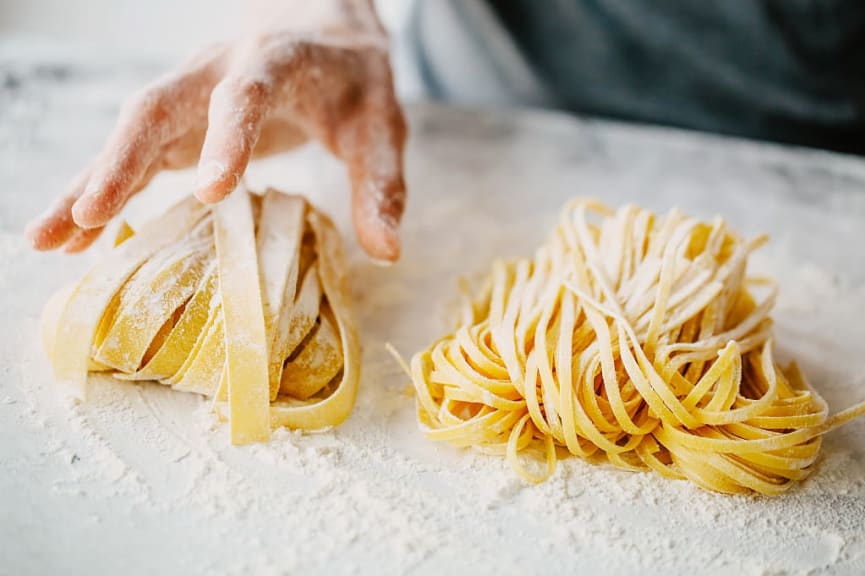
Italian pasta noodles
Italy is known for its cuisine and there is nothing quite like a rich, creamy sauce drizzled over any of the country’s popular pastas.
Browse our collection of best Italy Food & Wine Tours or prepare for your travels with Zicasso’s dedicated Italy Food & Wine Travel Guide to start planning your trip. When you are ready, you can speak with local travel specialist who will personalize any itinerary to your preferences to create your perfect Italy food tour.
Life-Enriching Travel Designed Just for You
- 1
Trips curated by the world’s top destination experts
- 2
Concierge-level service leading up to and during your trip
- 3
Unique, exclusive experiences and insider access





